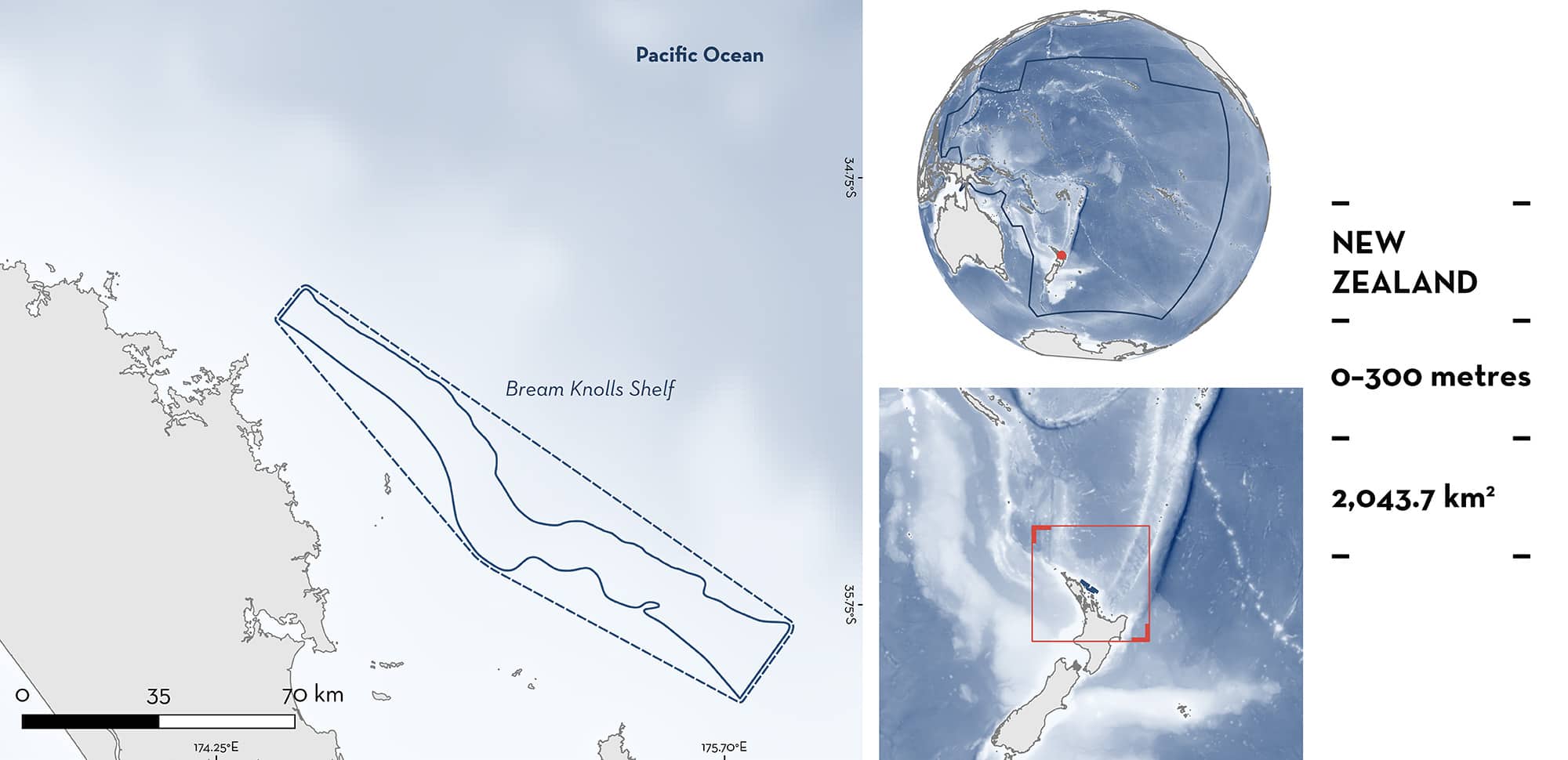ISRA FACTSHEETS
ISRA FACTSHEETS
NEW ZEALAND & PACIFIC ISLANDS REGION
Bream Knolls Shelf
Summary
Bream Knolls Shelf is situated off the northeast of the North Island in New Zealand. Primary and secondary production in the region is among the highest around the country, with the narrow continental shelf (<40 km wide) promoting upwelling in the area. Bream Knolls Shelf sits within the North Eastern North Island (offshore) Key Biodiversity Area. Within this area there are: threatened species and feeding areas (Spinetail Devil Ray Mobula mobular).
Download factsheet
Bream Knolls Shelf
DESCRIPTION OF HABITAT
Bream Knolls Shelf is situated off the northeast of the North Island in New Zealand. The waters here are temperate, with sea surface temperatures along the northeastern coast generally ranging between 15°C in the austral winter to 22°C in summer (Stevens et al. 2021). Nutrient-rich coastal waters are bordered by the warm seaward, nutrient-poor East Auckland Current which flows southeastward from the East Australian Current and the Tasman Front (Zeldis et al. 2004). Primary and secondary production in the region is notably high, with the narrow continental shelf (<40 km wide) promoting upwelling (Bradford-Grieve et al. 2006; Bury et al. 2012; Gaskin 2021). Upwelling events are common in early spring to early summer (Zeldis et al. 2004).
The area is located within the North Eastern North Island (offshore) Key Biodiversity area (KBA 2024).
This Important Shark and Ray Area is benthic and pelagic and is delineated from inshore and surface waters (0 m) to 300 m based on the bathymetry of the area.
CRITERION A
VULNERABILITY
One Qualifying Species considered threatened with extinction according to the IUCN Red List of Threatened Species regularly occurs in the area. This is the Endangered Spinetail Devil Ray (Marshall et al. 2022).
CRITERION C
SUB-CRITERION C2 – FEEDING AREAS
Bream Knolls Shelf is an important feeding area for one ray species.
Between 2004–2021, 317 records of Spinetail Devil Rays were collated using a combination of observer program records (n = 304) and citizen scientists (n = 13) (Ozaki 2023). Records from the Ministry of Primary Industries observer program were reported from the tuna purse seine and longline fisheries, related to devil ray (Mobula spp.) incidental catch, whereas citizen science reports were observations of free-swimming animals. All fisheries interactions reported that Spinetail Devil Rays were closely associated with the target schooling species likely foraging on smaller schooling fish (i.e., anchovies) and larger zooplankton such as euphausiids (Ozaki et al. 2024). Historic stomach content analysis of Spinetail Devil Rays killed in skipjack purse seines in the area have confirmed they were feeding on euphausiids (Bailey 1983). In addition, mobulids are known to target euphausiids in other locations (Rohner et al. 2017), adding support to foraging being the primary driver of aggregations in this area.
Between 2008–2024, 264 Spinetail Devil Ray interactions with fisheries (n = 447 individuals) were recorded in New Zealand waters (Finucci et al. 2021). Spinetail Devil Ray observations were largely during the summer (88% in January and February; Finucci et al. 2021). Almost all observations were from purse seine fisheries (94%) targeting Skipjack Tuna Katsuwonus pelamis and Blue Mackerel Scomber australasicus (Finucci et al. 2021). The other 6% of Spinetail Devil Ray observations were from surface longline fisheries targeting Bigeye Tuna Thunnus obesus or Swordfish Xiphias gladius. Spinetail Devil Ray interactions occurred at depths of 85–400 m (median = 252 m; Finucci et al. 2021). Comparative to the Bream Knolls Shelf, Spinetail Devil Ray interactions with fisheries in the Eastern Tropical Pacific are associated with areas of high productivity (Lezama-Ochoa et al. 2019). Primary and secondary productivity in this region is among the highest around the country, with the narrow continental shelf (<40 km wide) promoting upwelling in the area (Bradford-Grieve et al. 2006).
Only 10 records of Spinetail Devil Rays have been recorded on the west coast of the North Island of New Zealand (Ozaki 2023), highlighting the importance of the area for this species.
Download factsheet
SUBMIT A REQUEST
ISRA SPATIAL LAYER REQUEST
To make a request to download the ISRA Layer in either a GIS compatible Shapefile (.shp) or Google Earth compatible Keyhole Markup Language Zipped file (.kmz) please complete the following form. We will review your request and send the download details to you. We will endeavor to send you the requested files as soon as we can. However, please note that this is not an automated process, and before requests are responded to, they undergo internal review and authorization. As such, requests normally take 5–10 working days to process.
Should you have questions about the data or process, please do not hesitate to contact us.


